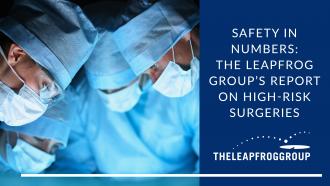
WASHINGTON D.C. - The Leapfrog Group, an independent national health care watchdog organization, today released Safety In Numbers: The Leapfrog Group’s Report on High-Risk Surgeries Performed at American Hospitals. The report analyzes eight high-risk procedures to determine which hospitals and surgeons perform enough of them to minimize the risk of patient harm or death, and whether hospitals actively monitor to assure that each surgery is necessary. The report finds that the vast majority of participating hospitals do not meet The Leapfrog Group’s minimum hospital or surgeon volume standards for safety nor do they have adequate policies in place to monitor for appropriateness. Rural hospitals are particularly challenged in meeting the standards.
Safety In Numbers summarizes findings from the 2018 Leapfrog Hospital Survey, submitted by over 2,000 hospitals nationwide. This is the first year Leapfrog reported the new surgical standard by hospital, assessing whether both hospitals and surgeons met volume standards, and whether hospitals monitored for surgical necessity. In addition to the report released today, individual hospital results are freely available and searchable at www.leapfroggroup.org/compare.
The eight high-risk procedures highlighted in Safety In Numbers were selected based on an intensive review of hundreds of studies conducted over the past decade, as well as guidance from Leapfrog’s National Inpatient Surgery Expert Panel. From this analysis, Leapfrog set evidence-based standards for the minimum number of procedures each hospital and each surgeon should perform.
Of the eight high-risk procedures assessed in the report, open abdominal aortic aneurysm repair and esophageal resection for cancer are the two procedures where the fewest hospitals met the volume standard for patient safety (less than 3% fully meeting for each). The procedure for which hospitals were most likely to meet the safety standard was bariatric surgery for weight loss (38%).
“It’s clear from this report that patients should be very careful before they choose a hospital for one of these high-risk procedures,” said Leah Binder, president and CEO of The Leapfrog Group. “Beyond the disturbing findings in this report, patients should worry even more about hospitals that decline to report this information at all, because candor and transparency is the necessary first step to improvement. We are confident that health system leaders will use these findings productively, in this case by concentrating volume in the most appropriate setting, and monitoring appropriateness better.”
Additionally, the report’s analysis shows significant variation between urban and rural hospitals, with urban hospitals outperforming rural hospitals across all eight high-risk procedures. For five of the eight procedures, no rural hospitals are fully meeting Leapfrog’s volume standard.
“No hospital and no surgeon should do only one or two of these procedures a year ever. The evidence is abundant: that’s not safe for patients,” said Binder. “Sometimes protecting patients means helping patients find a more appropriate place to have their surgery. That’s not always easy, but it’s the right thing to do.”
Equally important to achieving minimum volume standards is avoiding unnecessary and unneeded surgeries. To that end, Leapfrog encourages hospitals to have an appropriateness policy in place which includes processes aimed at monitoring surgical necessity and preventing overuse of surgical procedures. For all but one high-risk procedure assessed on the Survey, less than one-third of reporting hospitals indicate that they have a surgical appropriateness policy in place
More information about the importance of minimum surgical volumes for safety, as well as individual hospital results on surgical volumes and surgical appropriateness, are available on Leapfrog’s website at www.leapfroggroup.org.
